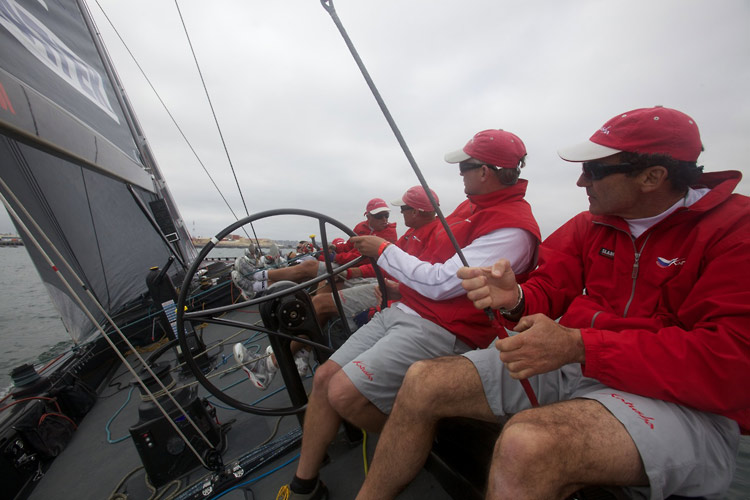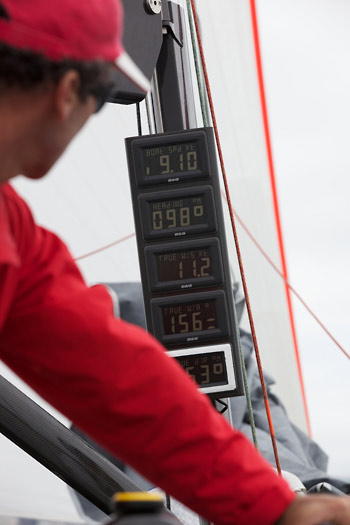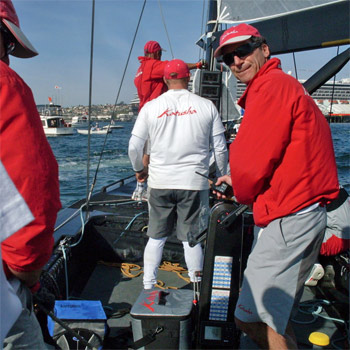|
March 7, 2011 |
||||||||||
|
Correspondent Diane Swintal got a guest spot onboard the RC44 Katusha, Saturday, and files this report: Let me establish one fact: there is no graceful way to enter a racing sailboat. I fancy myself a sailor, but I have never mastered the art of entering and exiting a rib, much less crossing to a tossing racing sailboat. Add in 14 knots of breeze and bouncing seas and you have a recipe for disaster -- thus I played my entry onto the RC44 regatta leader Katusha for Race Three on Saturday with some degree of caution. No one noticed my ungainly entrance anyway. In fact, no one noticed me at all. The team of nine, led by Paul Cayard, was far too busy getting ready for the start sequence. And I was just fine with that. I headed for my designated spot on the back of the detachable transom (it’s really clear where the transom comes off for shipping when you’re sitting on it).
The first thing to notice onboard about an RC44 is the movement. Not just the forward progress, slicing through the water, but the side-to-side movement. I try standing up for a while (okay, I admit, I want to look cool) but give up as the boat jerks at what seemed to be completely random moments. Between the breeze and the chop created by wind and spectator craft, safety seems much more important than the condition of my pants. Cayard grabs his spot between helmsman Bob “Peaches” Little and the runners (thus blocking my last non-carbon fiber handhold) and checks the breeze. He smiles briefly, and offers a quick “Hey, how you doing?” before the race begins. The 10-minute start sequence commences with Cayard keeping a constant cadence of instructions to Little and the tension onboard quickly ramps up. Everyone seems to want the pin end, as Katusha fights with Oracle and Artemis for position on a starting line that appears to be pin-biased. Fast off the line, Katusha stays left, with Cayard contemplating the building breeze on the right side of the course. Except for Cayard’s remarks and his steady flow of words with Little, it’s a very quiet boat. The silent intensity remains, with everyone handling their positions with ballet-like grace and speed. As for me, I discovered rather quickly that’s much easier to sit on a racing sailboat when you’ve got half your body shoved under lifelines, held firmly in place. Holding on to the back end of a boat, however, with no lifelines in sight and the side of that boat getting increasingly shorter as you go aft, is not such an easy thing. Especially when “down” is about 30 degrees down, and “out” is only about three feet behind you. Watching water rush behind a boat when you can practically reach out and touch it is just a bit disconcerting. Exciting, but mildly disconcerting. But the sailor inside takes over after a while, and the realization that you’re hanging on just a little tighter than the situation really warrants sets in. Loosen the grip just a little bit and really take in the view. However, the view is not a pleasant one for Cayard, as much of the fleet of 11 lies in front of Katusha. With a sixth place finish in the second race of the day, this isn’t what the regatta leader wants to see. Katusha tacks away from the left, with Bob getting a “Duck Artemis...duck Artemis” from Cayard. With the shifty breeze in the bay, which is dotted with high-rise hotels closer to the top mark, frustration is palpable. Katusha rounds in seventh position. Downwind sailing in the RC44, like any racing sailboat, is much easier -- at least the heel angle is easier. There’s no standing up and leaning on the shrouds to trim this boat, everyone’s on the high side, handling trimming duties and keeping the boat steady, only leaving the rail to work the grinders. And it’s Cayard more than anyone who handles the small grinding required to keep the spinnaker full. The cadence from Cayard is less pronounced downwind, more a matter of watching their position within the fleet, gauging the incoming breeze behind the boat and planning the next move. The constant assessments mean the crew knows exactly what’s coming, so nothing, especially the takedown, comes as a surprise.
It’s a chance for me to grab my camera out of my pocket, which is shoved up underneath the Slam PFD I’ve been given. It’s absolutely unbelievable how quickly the boat moves through the water, getting from Harbor Island to the turning mark just off the Broadway Pier in what seems like no time at all. And it’s back to that heel angle again, making darned sure that I’m across the boat not just in time, but in time with the crew, who are roll tacking. Katusha again stays left, tacking once to get back into the middle, and tacking right on top of Oracle (why does it seem so much closer than it does when I’m racing?) before grabbing the port layline and rounding just behind Ceeref in second place, an excellent gain on the beat. Katusha tries to gain on Ceeref during the run, throwing in a late gybe even though they’re reasonably sure the pin is closer. But with Ceeref on the pin, there’s no lane there. And the gybe isn’t the cleanest one of the day, so Katusha takes second place. The general consensus is that they should be happy with second and the regatta lead, even though the race seemed like a disaster for much of the chase. It’s the last race of the day, so Katusha heads into the Broadway Pier dock. Little turns around and starts in surprise, saying “I forgot you were there,” which is, I suppose, one of the nicest compliments. But even then, there’s no let up among the team -- the boat is cleaned up and the sails folded before the boat reaches the dock. With a hand from a crew member, I vault the three feet between the back of the boat and the dock and say my good-byes and thanks. It was quite an experience to be a fly on the wall of a race boat of this caliber and talent. And while I’d love to race at this level, I’m going to be happy to return to the relative calm of my J120 team, thank you very much! --Diane Swintal/©2011
CupInfo Links of Interest: RC44 website:
rc44.com |


